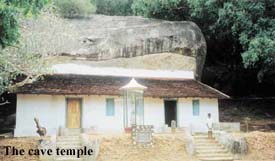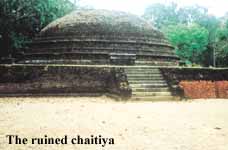 |

12th September 1999 |
News/Comment| Editorial/Opinion| Business| Sports | Mirror Magazine |
In Sigiriya's shadowancient Pidurangala cave temple is neglected by the authorities as well as visitors By Hiranthi FernandoSigiri Pidurangala Raja Maha Viharaya is just a short distance from the Sigiriya Rock fortress. Although its origins date back to the same period this site does not share the same glamour and renown of Sigiriya.Not even 10 percent of the visitors who flock to Sigiriya, spare a glance at this ancient shrine. Located down a dusty gravel track off the road leading to Sigiriya, the Pidurangala monastery, according to Dhaniyagama Ananda Thera, the chief priest of the temple, was built by King Kashyapa in the 5th Century A.D. "There is a strong connection between Sigiriya and Pidurangala," Ananda Thera says. "Sigiriya is only a kingdom. King Kashyapa's religious service is seen at Pidurangala. Kashyapa is known for the patricide he committed but his good works are forgotten. A tour of Sigiriya is incomplete without visiting Pidurangala." When Kashyapa discovered Sigiriya, there was a monastery where bhikkus lived and meditated in the lower levels of the rock. Kashyapa built a new aramaya for these bhikkus at the Pidurangala site nearby, before he started work on the Sigiriya fortress. Spread over 13 1/2 acres, the monastery gave sanctuary to 500 meditating bhikkus. The monastery was said to be 'panchavasa', complete with the five major ritual buildings, the Chapter House, Image House, the Bodhiya (Bo tree), Chaitya and the Sangharamaya or Sabha for the monks. According to a legend Bhikkhu Mahanama, the author of the Mahavamsa had lived at Pidurangala, Ananda Thera said. There is a brief reference to this in the Mahavamsa.
In the absence of the chief priest, eleven-year-old Nilantha, a young novice or 'Abiththaya' was the custodian of the keys to the cave. Inside the small, dark cave are five Buddha statues. Two standing images of the Buddha are old, having been found in the cave when it was excavated, Nilantha said. The other three statues had been constructed later. All the statues and the wall of the rock have been painted at some time, making it difficult to distinguish the old from the new. The paint on the old statues however, is peeling off revealing the stone beneath. Ananda Thera said he had requested the Archaeological Department to remove the outer layers of paint from the two ancient statues and restore them. There had been ancient paintings on the walls of the cave which had later been painted anew by the Bhikkus who occupied it. Ananda Thera said that it was noted in some inscriptions that they were done by King Kashyapa.
At the top of the hill, reached by a rough flight of steps behind the rock cave, is another large rock cave about 200 feet in length. Inside is a statue of a reclining Buddha. 48 1/2 feet in length, this is the largest Buddha image in Asia, built of clay and brick. Unfortunately, some sixty to seventy years ago, the head and upper portion of the statue were destroyed by treasure-hunting vandals. Ananda Thera says here too permission has been sought from the Archaeological Department for restoration. Well versed in its history, Ananda Thera who has been at Pidurangala for 13 years, explained that the head of the image was built facing east towards the Sigiriya Rock. It could apparently be seen from beside the well known Lion's Paws at Sigiriya. It is said the king worshipped the statue twice a day, standing by the Lion's Paws. It has also been noted the flowers carried by the maidens depicted in the Sigiriya frescoes face the Buddha image at Pidurangala, giving the impression that they were making their way here. If you go higher up on the roof of the cave, the ruins of two chaityas can be seen. Towards the feet of the sleeping Buddha image, the cave had been divided into 12 sections which were used as meditation cells by the monks. These cells too are said to have been the work of Kashyapa. The walls dividing the cells, made of earth and stone, are now in ruins. Traces of old paintings still remain on the vestiges of the cell walls. Lower down in a large clearing, excavations have uncovered the lower portion of a chaitya. Nearby, a series of stone columns indicated the site of the pirivena, where the young Bhikkus were taught. The top of the chaitya has broken off. Three stone steps and a rough moonstone slab mark the entrance to the Simamalaka. "Although Pidurangala belongs to the Archaeological Department, there have been so far no plans for conservation," Ananda Thera said. "Some bricks have been brought to repair the chaitya but we do not know what the plans are. We are maintaining the temple and its buildings with private donations," he said. |
||
 |
Front Page| News/Comment| Editorial/Opinion| Business| Sports | Mirror Magazine |
|
 |
|
|
 At
Pidurangala, temple buildings are located on both sides of the gravel track.
A flight of stone steps leads to the rock cave temple. A brick building
had been constructed in 1933, enclosing the mouth of the cave.
At
Pidurangala, temple buildings are located on both sides of the gravel track.
A flight of stone steps leads to the rock cave temple. A brick building
had been constructed in 1933, enclosing the mouth of the cave.
 They
are said to have been carved out of stone by the same craftsmen who had
executed the carving of the Aukana statue during the time of Kashyapa's
father King Datusena.
They
are said to have been carved out of stone by the same craftsmen who had
executed the carving of the Aukana statue during the time of Kashyapa's
father King Datusena.